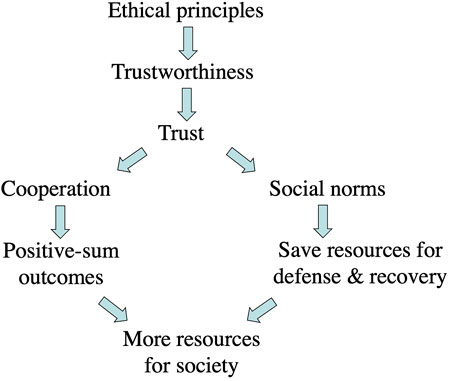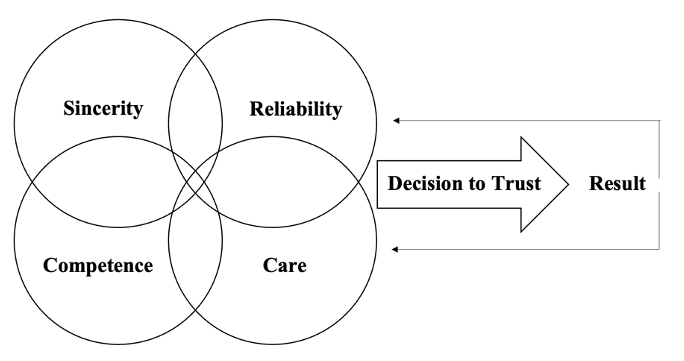Chapter 6: Trustworthy

Trust is vital to an organization. Trust within an organization relies on all parties involved even the competition. Interpersonal trust ‘‘encompasses one’s willingness to accept vulnerability based on the expectation regarding the behavior of another party that will produce some positive outcome in the future” (Krueger & Meyer-Lindenberg, 2019). In more simple language, trust is “choosing to risk making something you value vulnerable to another person’s actions” (Feltman, 2011). For example, trusting that another member in a group project will fulfill their portion of the assignment by the deadline (Remixed from Matkin et al., 2023).
Distrust, on the other hand, is defined as the belief that “what is important to me is not safe with this person in this situation (or any situation)” (Feltman, 2011). When we’re with someone we trust, we feel safe and able to be open. On the contrary, when we’re with someone we have not built trust with, we might feel a need to protect ourselves. The emotions connected to trust are care, open-handedness, and curiosity, while the feelings related to distrust are resignation, bitterness, and fear. When experiencing trust, we are prone to cooperation and collaboration, open communication, supporting others, thinking critically about our behaviors, and expecting the best from people and situations. When experiencing distrust, we are likely to be defensive, blame and shame others, judge ourselves and others, withhold information, and expect the worst from people and situations (Remixed from Matkin et al., 2023).
Choosing trust or distrust has been described as a risk assessment or a social dilemma. In other words, what is the likelihood that the other person will support or harm you, and to what extent do you make yourself vulnerable to their actions? Neuroscience supports the perspective of trust as a risk assessment. Specifically, reward networks in our brains “determine the anticipated reward for trusting another person” (Krueger & Meyer-Lindenberg, 2019), while the salience network ties negative feelings to the risk of betrayal by another person. Our brains figure out context-based strategies for trust through the central-executive network, as well as relationship-based trustworthiness (e.g., trusting a partner) through the default-mode network. In sum, trust is not only something we feel in our relationships, but it is also something that occurs in our brains (Remixed from Matkin et al., 2023).
Effects of Trust

Trust appears at many levels, organizational or managerial, and is manifested in the way, frequency, and quality of interaction between employees and managers (Saylor). A trusting relationship between the employer and the employees increases loyalty and productivity (Kleynhans et al., 2022). If a leader is perceived as trustworthy, the employees are more likely to be engaged and connected within the organization (Liu et al., 2022)
The diagram below shows the flow from clear ethical principles to the creation of new resources for society (Kuipers, 2022). This is related to artificial intelligence, but the same could be said in order situations. Where there are clear ethical guidelines and where there is trust there will also be: positive collaboration, connection, and ultimately: innovation.

Building and Maintaining Trust
Building trust is considered an essential activity in managerial leadership. However, the task of building and maintaining trust is complex. A leader’s traits, behavior, leadership style, and skills all matter in building trust and creating an impression of trustworthiness. By implication, a leader’s mundane behavior plays a key role; trust is built and maintained by a leader’s “daily deeds” (Saylor). Employees in organizations create trustworthiness by their daily behavior and actions (Saylor).
However, building and maintaining trust is a commitment. If the actions and the words of the leadership do not align, trust will be difficult to maintain over time (Kleynhans et al., 2022). Feelings of insecurity appearing in workplaces may be often a reason for atmosphere- related problems such as teasing, conflicts, and disputes. All of them affect the level of trust. Mental well-being is largely sustained by emotional support such as appreciation, respect, openness, and feedback. A commitment to the work and the organization is reflected in employees’ work motivation and satisfaction (i.e., work welfare) (Saylor).
This is an opportunity for authentic leaders to build trust by being honest, transparent, and genuine. So how do you build trust? There are four key elements: sincerity, reliability, competence, and care.

Collectively, these four aspects of trust lead us to either choose to trust someone or choose not to trust someone. When we choose to trust someone, we monitor the outcome, asking ourselves questions such as, “Were the results positive? Did they honor our trust?” If the answer to these questions is “yes,” our assessment of the other individual continues to grow, and we view them as more sincere, more reliable, more competent, and/or more caring (Matkin et al., 2023).
Trust fuels our vulnerability, and vulnerability fuels our trust. In other words, vulnerability is critical to building trust. We must be honest with others for them to know we are sincere and that we care. Likewise, trust allows us to be vulnerable. Having an idea that someone will respond to our vulnerability with kindness (i.e., a positive outcome) provides us with the sense of safety and security required to self-disclose. As such, trust and vulnerability are iterative processes, building upon each other to foster strong relationships. As trust builds in an interpersonal relationship, so does our willingness to be vulnerable. As vulnerability occurs in our interpersonal relationships, trust builds (Matkin et al., 2023).
References
Kleynhans, D., Heyns, M., Stander, M., & de Beer (2022). Authentic leadership, trust (in the leader), and flourishing: Does precariousness matter? Frontiers in Psychology, 13. https://doi.org/10.3389/fpsyg.2022.798759
Kuipers, B. (2022). Trust and cooperation. Frontiers in Robotics and AI, 9. https://doi.org/10.3389/frobt.2022.676767
Liu, D., Bakari, H., Niaz, M., Zhang, Q., & Shah, I. (2022). Impact of managerial trustworthy behavior on employee engagement: Mediating role of perceived insider status. Frontiers in Psychology, 13. https://doi.org/10.3389/fpsyg.2022.942697
Matkin, G., Headrick, J., & Sunderman, H. (2023). Developing human potential. Retrieved on October 17, 2023 from https://pressbooks.nebraska.edu/developinghumanpotential/chapter/developing-trust-being-trustworthy/
Saylor Academy (n.d.). Trustworthiness and its impact on leadership. Managing People. Retrieved on October 17, 2023 from https://learn.saylor.org/mod/book/view.php?id=60538&chapterid=48385

